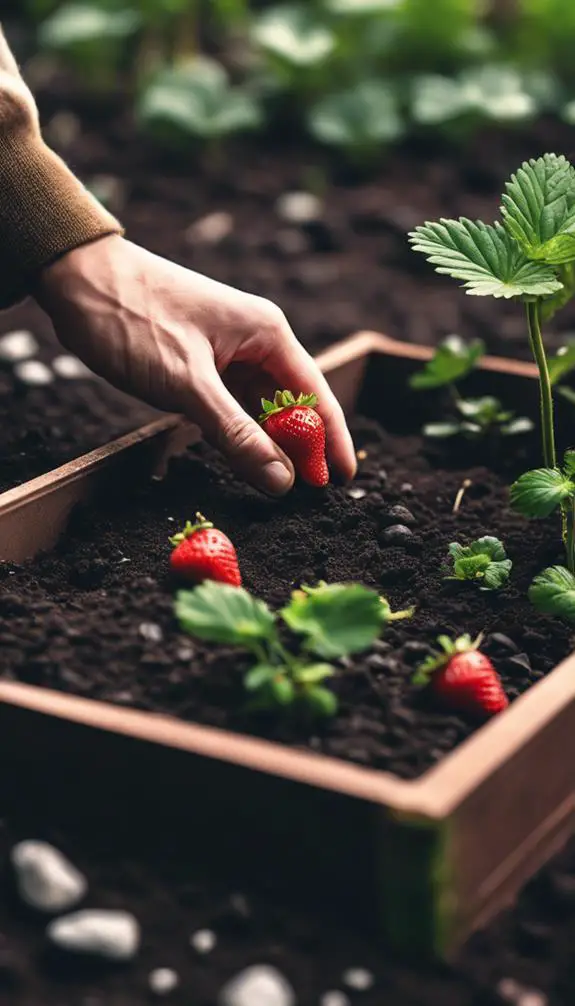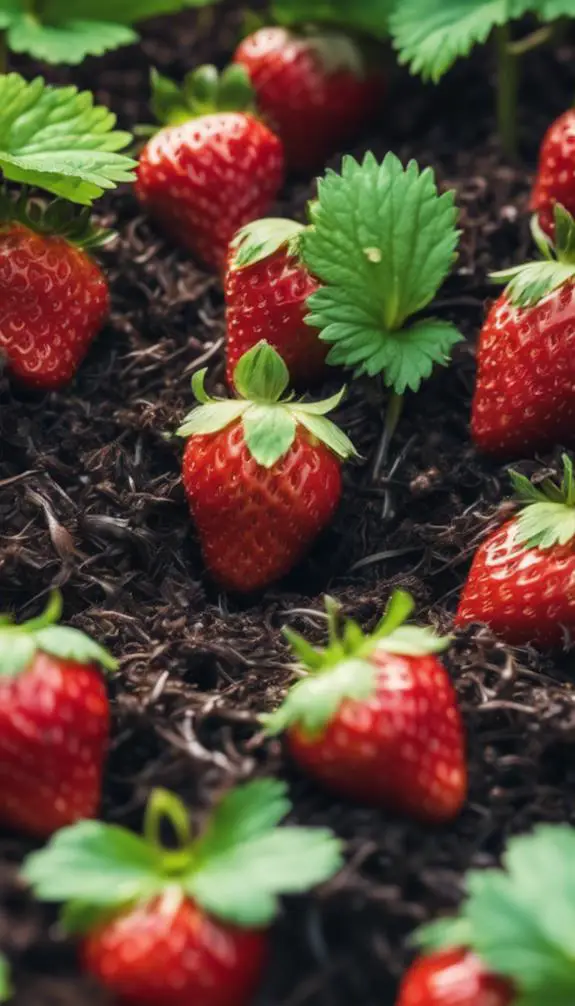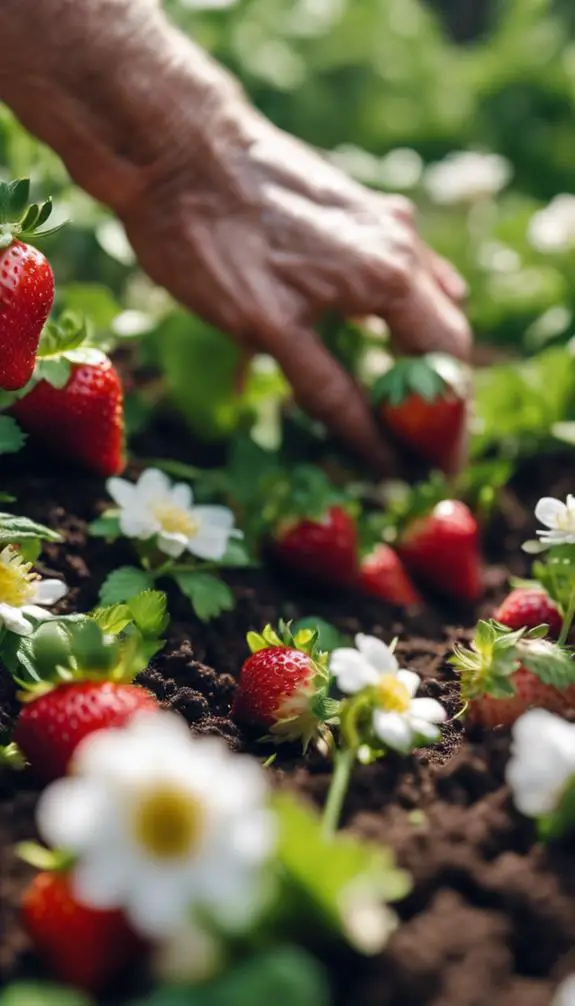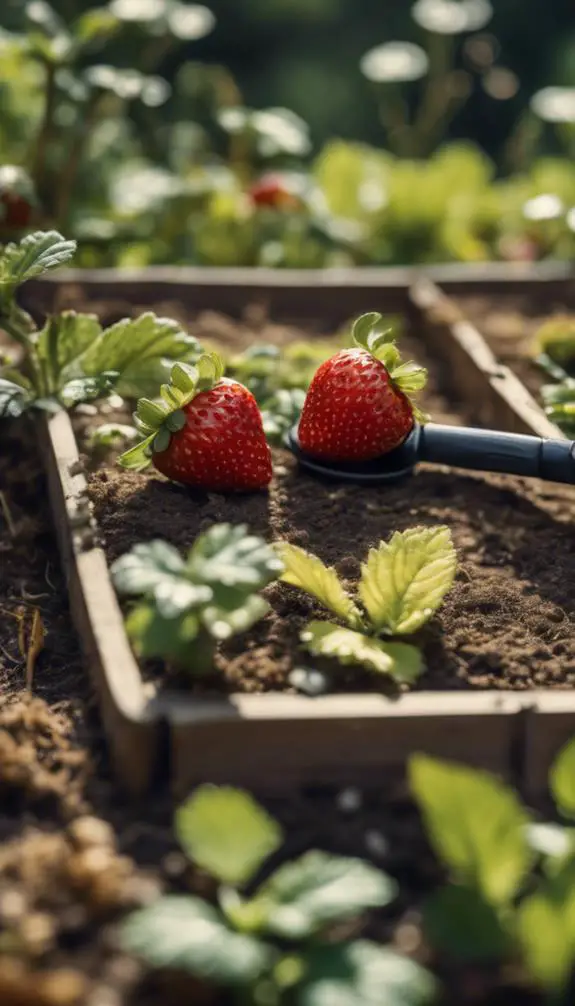As you start planning your raised bed strawberry garden, you'll want to get the basics right. You've likely heard that strawberries are easy to grow, but did you know that choosing the wrong variety for your climate can lead to disappointing results? That's why selecting a type that flourishes in your local conditions is vital. Once you've got the right variety, you'll need to prepare the soil and plant the strawberries at the right spacing. But that's just the beginning – there are a few more key steps to take to guarantee a bountiful harvest.
Summary
- Select the right strawberry variety for your region's climate, considering factors like temperature, humidity, and sunlight exposure.
- Prepare the raised bed with well-structured, nutrient-rich soil that has a pH between 5.5 and 6.5 and is rich in organic matter.
- Plant strawberries at the right depth and spacing, with June-bearing varieties spaced 18-24 inches apart and day-neutral and ever-bearing varieties spaced 12-18 inches apart.
- Provide consistent moisture, about 1 inch of water per week, and apply a 2-3 inch layer of organic mulch to retain moisture and suppress weeds.
- Guarantee at least six hours of direct sunlight daily and provide adequate air circulation to promote healthy growth and fruit production.
Choose the Right Strawberry Variety

Selecting the right strawberry variety is crucial for a successful harvest, as different types thrive in distinct climates and have varying levels of disease resistance and flavor profiles.
You'll want to ponder factors like your region's temperature, humidity, and sunlight exposure when choosing a variety. Some popular strawberry types include 'Everbearing', 'June-bearing', and 'Day-neutral'.
Each has its own strengths, such as high yields, extended harvest seasons, or excellent flavor profiles. Research the specific needs and benefits of each variety to guarantee you're making an informed decision.
Ponder factors like disease resistance, fruit size, and flavor intensity to find the perfect fit for your raised bed. By selecting the right variety, you'll be well on your way to a bountiful strawberry harvest.
Prepare the Raised Bed Soil

Three key components of a thriving strawberry bed are a well-structured raised bed, ideal irrigation, and, most importantly, a nutrient-rich soil.
To prepare your raised bed soil, start by testing its pH level using a soil testing kit. Strawberries prefer a slightly acidic to neutral soil pH, ranging from 5.5 to 6.5.
Based on the test results, you may need to add soil amendments like lime to raise the pH or elemental sulfur to lower it. Additionally, incorporate organic matter like compost or well-rotted manure to improve soil structure and fertility.
This will provide your strawberries with the necessary nutrients for peak growth and fruit production.
Obtain Strawberry Plants or Seeds

Your strawberry patch's success hinges on using high-quality plants or seeds.
When selecting seeds, opt for disease-resistant and day-neutral or ever-bearing varieties, which produce fewer runners but more fruit. Guarantee the seeds are fresh and suitable for your region's climate.
For seed selection, consider factors such as fruit size, flavor, and yield. You can purchase seeds from reputable online suppliers or local nurseries.
If you prefer to start with established plants, source them from a trusted nursery. Look for nurseries that specialize in strawberry plants and offer disease-free, certified stock.
This will give your strawberry patch a strong foundation for a bountiful harvest.
Plant Strawberries in the Bed

You're now ready to plant strawberries in the bed, but before you start, you'll need to prepare the soil to the right depth.
You'll also need to choose a strawberry variety that's suitable for your climate and the amount of space you have available.
Proper spacing is critical, so make sure you plan carefully to give your strawberries room to grow.
Prepare the Soil Depth
Proper soil preparation is the foundation of a thriving strawberry bed.
Before planting, you'll need to test your soil composition to determine its pH level and nutrient content. You can purchase a soil testing kit or send a sample to a lab for analysis.
Based on the results, you may need to adjust the pH level by adding lime or sulfur. Strawberries prefer a slightly acidic to neutral soil pH, ranging from 5.5 to 6.5.
Guarantee your soil has a well-balanced composition with adequate nitrogen, phosphorus, and potassium. Add organic matter like compost or well-rotted manure to improve soil structure and fertility.
Once you've prepared the soil, you're ready to plant your strawberries.
Choose the Right Variety
With your soil prepared, it's now time to select the ideal strawberry variety for your bed.
You'll want to ponder factors like flavor profiles, disease resistance, and growth habits. Look for strawberry breeding programs that prioritize traits like high yields, compact growth, and pest tolerance.
Flavor profiles range from sweet and mild to tart and tangy, so choose a variety that suits your taste preferences. Some popular varieties include 'Albion', 'Everbearing', and 'Florence'.
Research each option carefully to verify you're getting the best fit for your raised bed. By selecting the right variety, you'll be well on your way to a bountiful strawberry harvest.
Space Them Correctly
Planting strawberries in the bed requires careful planning to guarantee each plant has enough space to thrive.
You want to achieve ideal density, allowing each strawberry plant to receive adequate sunlight, water, and nutrients. For June-bearing strawberries, space them 18-24 inches apart, while day-neutral and ever-bearing varieties can be spaced 12-18 inches apart.
Consider a triangular pattern, which allows for better air circulation and sunlight penetration.
When planting, gently spread the roots outwards, and firm the soil around the crown.
Proper strawberry spacing certifies healthy growth, increased yields, and easier harvesting.
Water and Mulch the Bed

Three to four weeks after planting, your strawberry bed needs consistent moisture, especially during the first year.
Water the bed gently but thoroughly, making sure the soil is moist but not waterlogged. Aim to provide about 1 inch of water per week, either from rain or irrigation.
Proper bed preparation is vital, so guarantee the soil drains well and isn't compacted.
Apply a 2-3 inch layer of organic mulch, such as straw or wood chips, around the plants. Mulch benefits include retaining moisture, suppressing weeds, and regulating soil temperature.
As you mulch, keep it a few inches away from the plant crowns to prevent rot.
Provide Adequate Sunlight and Air

You'll want to guarantee your strawberry plants receive at least six hours of direct sunlight daily, as insufficient sunlight exposure can substantially reduce yields.
Additionally, providing adequate air circulation is vital, as strawberries are susceptible to fungal diseases that thrive in humid environments. By positioning your plants to maximize sunlight and air circulation, you'll create an ideal environment for healthy growth and fruit production.
Sunlight Exposure Matters
As you prepare to grow strawberries, crucial to recognize the critical role sunlight exposure plays in their development.
Strawberries require at least six hours of direct sunlight daily, with morning sun being the most beneficial. During this time, the plants absorb essential UV rays, promoting healthy growth and fruit production.
Guarantee your raised bed receives adequate sunlight hours, ideally between 6-10 am, when the sun's rays are gentler. Avoid shading your strawberries, as this can lead to weak and spindly growth.
Air Circulation Essentials
Proper air circulation is vital in strawberry cultivation, and it's closely tied to sunlight exposure.
As you design your raised bed, guarantee that air can circulate freely around your strawberry plants. You can achieve this by leaving about 12 inches of space between each plant and incorporating a fan circulation system to enhance airflow.
Additionally, consider installing ventilation systems, such as mesh screens or trellises, to promote air movement and reduce humidity. This will help prevent fungal diseases that thrive in stagnant air.
Fertilize the Strawberry Plants

When strawberries are producing flowers and fruit, they require a balanced diet of nutrients to sustain their growth and productivity.
You'll want to fertilize your strawberry plants regularly to guarantee they're getting the nutrients they need. Aim for a fertilizer with a balanced N-P-K ratio (nitrogen-phosphorus-potassium) of 10-10-10 or 20-20-20.
Soil pH affects nutrient availability, so test your soil regularly and adjust the pH if necessary. Adding organic matter like compost or well-rotted manure can help maintain a healthy soil pH and provide essential micronutrients.
Apply fertilizer according to the product's instructions, taking care not to over-fertilize, which can damage your plants. With regular fertilization, your strawberries will thrive and produce delicious fruit.
Control Weeds and Pests Naturally

Many weeds and pests can compete with your strawberry plants for water, nutrients, and light, reducing their growth and productivity.
To control them naturally, you can use companion planting, which involves growing plants alongside your strawberries that repel pests or improve soil health. For example, basil repels aphids and whiteflies, while marigolds deter nematodes.
Another effective method is to install weed barriers, such as landscape fabric or mulch, around your raised bed. These barriers prevent weeds from germinating and reduce soil moisture loss.
Additionally, you can use physical barriers, like copper tape, to deter slugs and snails. By implementing these natural control methods, you'll create a healthy and balanced ecosystem for your strawberry plants to thrive.
Prune Strawberry Plants Regularly

By maintaining a weed- and pest-free environment, you've set the stage for your strawberry plants to flourish.
Now, it's vital to prune them regularly to promote healthy growth and maximize yields. Establish a pruning schedule to guarantee your strawberry plants receive the attention they need.
Remove any dead or damaged leaves and stems, as well as any runners that are growing outside the raised bed. This will redirect the plant's energy towards fruit production.
For June-bearing strawberries, prune in the summer after harvesting, and for ever-bearing varieties, prune in the fall after the last harvest.
Regular strawberry pruning will encourage bushy growth, increase fruiting, and reduce disease susceptibility.
Divide and Transplant Strawberries

You'll need to prepare the new soil before transplanting your strawberries, making sure it's well-draining and rich in organic matter.
Next, you'll dig up and separate the strawberry plants, carefully teasing apart the roots and crowns.
Once you've prepared the divisions, you can replant them in their new location, giving them enough space to thrive.
Prepare the New Soil
As one prepares to divide and transplant strawberries, the quality of the new soil takes center stage.
You'll want to guarantee the soil pH is between 5.5 and 6.5, as strawberries thrive in slightly acidic to neutral soil.
Next, focus on compost quality. Mix in a 2-inch layer of rich, nutrient-dense compost to provide essential nutrients for your strawberries.
Aim for a mix with a high organic matter content and a balanced carbon-to-nitrogen ratio. This will help support healthy microbial activity and promote robust plant growth.
With the right soil pH and compost quality, you'll be well on your way to creating an ideal environment for your strawberries to flourish.
Dig and Separate Plants
Now that your soil is prepared, it's time to focus on the strawberries themselves.
Dig up the strawberry plants from their previous location, taking care not to damage the roots.
Gently separate the plants, making sure each division has at least one "crown" (where the stems meet the roots) and some healthy strawberry roots.
This will guarantee each new plant has a strong foundation for growth.
Trim away any weak or dead roots to promote healthy development.
You'll be left with multiple divisions, each ready to be replanted in their new home.
Replant the Divisions
Replanting the strawberry divisions into their new home is a pivotal step in the strawberry-growing process.
You've carefully separated the plants, and now it's time to give them a fresh start. Division timing is essential, as strawberries are typically replanted in the early spring or fall when the weather is mild.
This allows the plants to establish themselves before extreme temperatures set in. When replanting, verify each division has at least one "crown" (where the leaves meet the roots) and a few roots attached.
Plant them in your raised bed, spacing them about 12-18 inches apart, and water well. Consider the plant hardiness zone you're in and choose a variety that thrives in your region.
With proper care, your strawberries will flourish in their new home.
Protect From Extreme Weather

Your strawberry plants' fragile nature makes them vulnerable to extreme weather conditions, which can substantially impact their productivity and overall health.
To shield them from harsh climate conditions, implement weather barriers and climate shielding strategies. Install a trellis or a cold frame to provide structural support and protection from strong winds, hail, and frost.
You can also use row covers or individual plant covers to shield your strawberries from intense sunlight, heavy rainfall, and extreme temperatures. Additionally, consider using mulch to regulate soil moisture and temperature.
Monitor for Common Diseases

Inspect your strawberry plants regularly to catch early signs of common diseases that can decimate your crop.
Fungal infections, such as powdery mildew and botrytis, can cause white or grey patches on leaves and stems, leading to reduced yields and plant death.
Bacterial blights, like crown rot and leaf spot, can cause soft, mushy stems and leaves, and can be fatal if left untreated.
Check for these signs daily, and remove infected plants or plant parts to prevent the disease from spreading. Use organic fungicides or bactericides as needed, and guarantee good air circulation, watering, and sanitation practices to prevent disease outbreaks.
Enjoy Your Strawberry Harvest

About sixty to ninety days after planting, you'll be ready to start enjoying the fruits of your labor – literally!
Check your strawberry plants daily for ripe berries, as they're highly perishable. Gently grasp the berry and twist it slightly to release it from the stem. Avoid squeezing or pulling, which can damage the plant or berry.
Harvest your strawberries in the morning, when they're at their sweetest and freshest. Enjoy your fresh harvest as a sweet delight in salads, smoothies, or as a healthy snack.
Regular harvesting will encourage your plants to produce more berries, so be sure to pick them regularly to keep the harvest coming!
FAQs
Can I Grow Strawberries in a Raised Bed With Poor Drainage?
You can't grow strawberries in a raised bed with poor drainage, as wet soil and waterlogged roots will rot them. You'll need to improve drainage or use a raised bed with built-in drainage to prevent root rot and guarantee healthy growth.
Will Strawberries in a Raised Bed Attract Bees and Other Pollinators?
You'll attract pollinators like bees to your strawberries in a raised bed by creating a pollinator-friendly environment with bee hotels and diverse flowers, increasing the chances of successful pollination and a bountiful harvest.
Can I Use a Trellis to Support Strawberry Plants in a Raised Bed?
You can utilize a trellis to support strawberry plants, employing strawberry training techniques like vertical or horizontal support systems, and choosing from various trellis styles, such as teepees, obelisks, or wall-mounted options, to optimize space and yields.
How Often Should I Rotate Strawberry Plants in a Raised Bed?
You'll want to rotate your strawberry plants every 2-3 years to maintain soil health and prevent disease buildup; this crop rotation guarantees a soil refresh, allowing your plants to thrive in their raised bed environment.
Can I Grow Strawberries in a Raised Bed on a Balcony or Patio?
You can definitely grow strawberries on your balcony or patio, maximizing balcony space and enhancing patio decor. Certify your raised bed receives 6-8 hours of direct sunlight and is at least 6-8 inches deep for ideal strawberry growth.
Conclusion
You've successfully grown strawberries in a raised bed! Now, enjoy the fruits of your labor. Harvest strawberries when they're bright red and fully ripe. Pick them regularly to encourage continuous production. Store them in a cool, dry place to keep them fresh. With proper care, your strawberry plants will thrive and provide a bountiful harvest for years to come.




